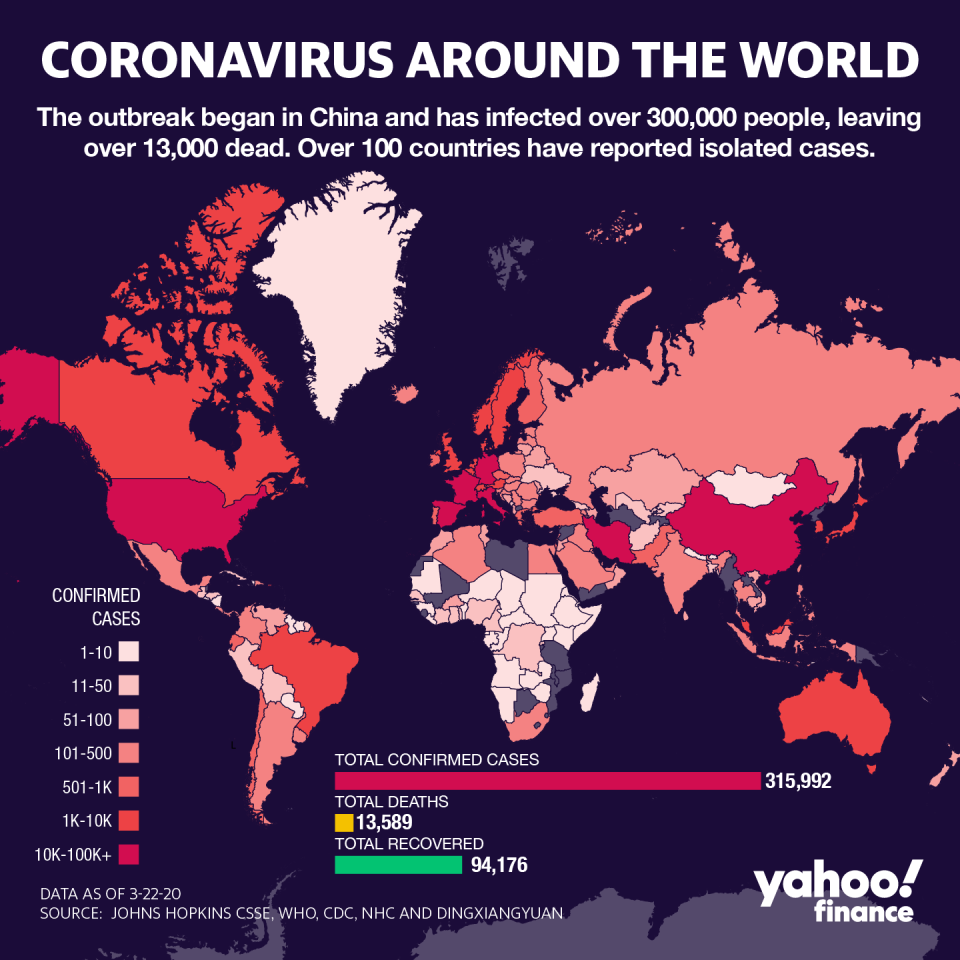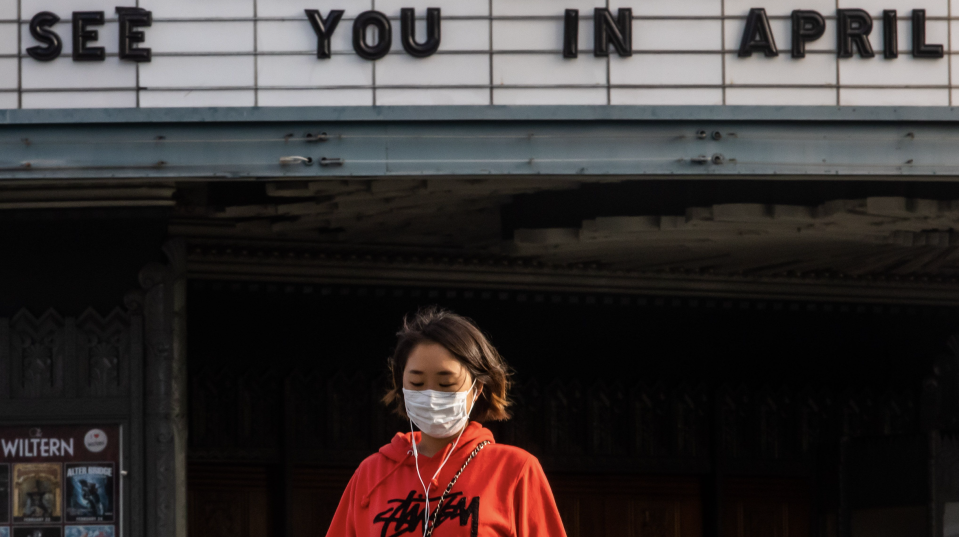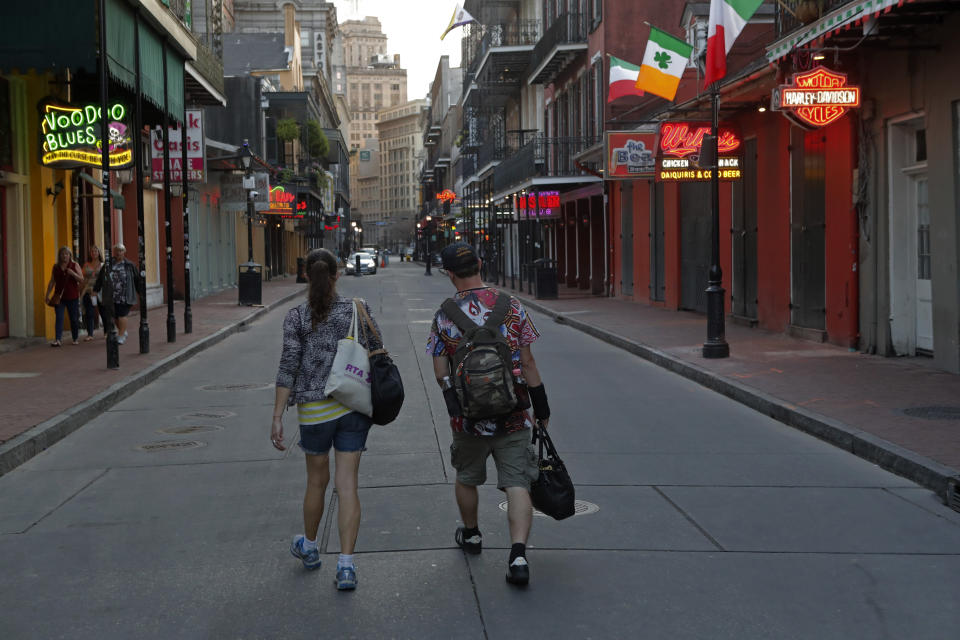'Unrecognizable': Experts warn of historic collapse in economic activity
As the coronavirus continues to spread, there is no question the U.S. economy is taking a major hit.
Economists at Goldman Sachs warn GDP will collapse at a 24% rate, a far cry from the “4, 5, and even 6%” growth scenario presented by President Trump just over two years ago.
“We are in a global recession,” Allianz’s Mohamed El-Erian said on Yahoo Finance’s On The Move. “We're in a global recession because of what economic sudden stops do.”
See Also: What is a recession? Here are the basics
Economic contractions often happen gradually, not suddenly, giving policymakers and business leaders some time to adjust so that growth may resume. The coronavirus pandemic, however, has forced economic activity to grind to a halt (i.e. sudden stop) as social distancing has effectively shutdown the massive global discretionary services industry, while also disrupting the massive global manufactured goods supply chain.

“[Sudden stops] are normally experienced by fragile states or by a community hit by a natural disaster, where everything comes to a stop,” El-Erian added. “They've never been felt at a level of a country as systemically important as China or the U.S., or Europe. And they've certainly never been felt at the level of global economy. So this is unprecedented.”
Because of the unprecedented nature and scale of what the world is facing, economists have struggled to model how badly things are getting.
“There is no blueprint for the current shock, and uncertainty about the extent of contagion and the economic consequences is overwhelming,” Credit Suisse economist James Sweeney said.

Last Monday, however, Pantheon Macroeconomics’ Ian Shepherdson made a splash by taking a “guess.”
“We now guesstimate that second quarter GDP will drop at a 10% annualized rate, after a 2% fall in Q1,” Shepherdson said. “We are pencilling in a 20% plunge in discretionary consumers' spending in the second quarter, enough alone to subtract some eight percentage points from GDP growth.“
The calculus involved in making such forecasts is further complicated by the fact the policy response (both monetary and fiscal) continues to be a work in progress. And so the form, timing and ultimate impact of the response remains impossible to know. Though, most agree that the response will fuel a surge in activity once health officials tell us the coronavirus is under control.

Shepherdson’s note was followed by a slew of incredibly grim forecasts for the second quarter, coming from economists forced to use unconventional methods. Those economists were also encourage by the prospect of stimulus. All warned clients that every estimate came with a huge margin of error.
Below is a sampling of what was published last week. (Quarterly percentage figures reflect quarter-on-quarter annualized growth rates):
Goldman Sachs — “Historic”: -6% in Q1, -24% in Q2, +12% in Q3, +10% in Q4; full-year growth at -3.8%
“Over the last few days social distancing measures have shut down normal life in much of the US,” Goldman Sachs economists led by Jan Hatzius wrote on Friday. “News reports point to a sudden surge in layoffs and a collapse in spending, both historic in size and speed, as well as shutdowns of many schools, stores, offices, manufacturing plants, and construction sites.”
Credit Suisse — “Unrecognizable”: -1.5% in Q1, -12% in Q2; full-year growth at -0.9%
“Economic data in the near future will be not just bad, but unrecognizable,” Credit Suisse economists led by James Sweeney said on Friday. “Anomalies will be ubiquitous and old statistical relationships within economic data or between market and macro data might not always hold... There is no blueprint for the current shock, and uncertainty about the extent of contagion and the economic consequences is overwhelming.”
UBS — “Impossible”: -2.1% in Q1, -9.5% in Q2; +2.1% in Q3, +6.7% in Q4; full-year growth at -0.9%
“To say that uncertainty about the forecast is elevated would be an acute understatement,” UBS economists led by Seth Carpenter said on Thursday. “And the same uncertainty applies when forecasting every other economy in the world. Consequently, the path of future global trade is near impossible to predict.”

Barclays — “Deeper disruptive effects”: -0.5% in Q1, -7.0% in Q2; +0.0% in Q3, +2.5% in Q4; full-year growth at -0.6%
“With timely evidence from the usual economic data releases still in short supply, we take an unusually strong signal from available survey indicators, as well as some unconventional indicators that do not usually feature in our forecast apparatus,” Barclays economists led by Michael Gapen said on Thursday. “This [base case] scenario continues to assume that ‘hotspots’ eventually occur in states that encompass 60% of overall US activity, but with deeper disruptive effects than we projected previously... Given the depth of the disruptions, fiscal and monetary policy measures would be less effective at containing second-round fallout through various channels (such as credit, uncertainty, and confidence) than before.“
Bank of America — “Large uncertainty”: +0.5% in Q1, -12.0% in Q2; +3.0% in Q3, +4.0% in Q4; full-year growth at -0.8%
“We believe that the US economy has fallen into recession, joining the rest of the world, and it is a deep plunge,” Bank of America economists led by Michelle Meyer wrote on Thursday. “Jobs will be lost, wealth will be destroyed and confidence depressed. The salvation will come if there is a targeted and aggressive policy response to offset the loss of economic activity and ensure a sound financial system... There is a large uncertainty band around the forecasts.”
JPMorgan — “Pervasive ‘Knightian uncertainty’”: -4.0% in Q1, -14.0% in Q2; +8.0% in Q3, +4.0% in Q4; full-year growth at -1.5%
“In economic parlance, the current environment is one of pervasive ‘Knightian uncertainty’ — that is, an unknown for which we cannot even quantify the odds of various outcomes,” JPMorgan economists led by Michael Feroli wrote on Wednesday. “While that description clearly applies to the present situation, the very process of producing a forecast still possesses some value, as it can highlight the key assumptions needed to break past this uncertainty“
Deutsche Bank — “Truly unprecedented”: +0.6% in Q1, -12.9% in Q2
“We cannot stress enough the degree of uncertainty surrounding these projections,” Deutsche Bank economists led by Peter Hooper said. “These are truly unprecedented events with no adequate historical example with which to precisely anchor our forecast. The evolution of the virus is also highly uncertain.“
The first official estimate of Q2 GDP is scheduled to be published by the Bureau of Economic Analysis on July 30.
—
Sam Ro is managing editor at Yahoo Finance. Follow him on Twitter: @SamRo
Read more:
'We are all in the dark': Wall Street's smartest are making guesstimates
Why Warren Buffett’s 2008 message to investors was perfectly timed
Why a big market rally right now is no reason to get excited
Something dangerous is happening beneath the surface of the selloff
The incredibly bullish force investors can’t afford to ignore
Follow Yahoo Finance on Twitter, Facebook, Instagram, Flipboard, LinkedIn, and reddit.
Find live stock market quotes and the latest business and finance news
For tutorials and information on investing and trading stocks, check out Cashay

